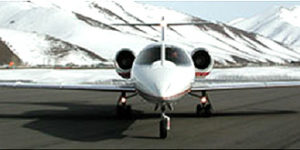Bombardier Learjet 24/25/31 Series Available for Cargo Aircraft Charter
Type: Jet Airliner
National Origin: United States
Manufacturer: Learjet
First Flight: January 24, 1966
Status: In Service
Number Built: 500+
Variants: 24/25/31
The Learjet 24 is an American six to eight seat (two crew and four to six passengers) twin-engine, high speed business jet.
The Learjet 25 is an American ten seat (two crew and eight passengers) twin-engine, high speed business jet aircraft.
The cabin interior can be converted to several different configurations to allow for cargo and medevacs. Due to the ease of converting the cabin the Learjet 25 has found a niche as a medevac aircraft. This is achieved by removing the starboard seating to allow for a stretcher, mounting oxygen bottles and Intravenous drip equipment. The two flight crew are then supplemented by either a doctor or flight nurse or both. The Model 25C also has an optional two bed sleeping compartment.
Despite being used at lower altitudes and equipped with small landing gear, the Learjet can land on gravel runways if it is fitted with a special “gravel kit”. It is possible for gravel from an improperly packed gravel runway to be sucked into the engines causing “Foreign object damage”, thus the need for the kit.
The Learjet 31 is an American ten seat (two crew and eight passengers) twin-engine, high speed business jet.
The Learjet Model 31 is, arguably, the ultimate realization of the original Learjet series (dating back to the model 23 of 1963). Essentially combining the fuselage and engines of the model 35/36 with the “Longhorn” wing of the 28, 29 and 50 models, results in performance which is equaled by few aircraft. Normal cruise altitudes range from 41,000 to 47,000 feet (12,500-14,900 m) and the aircraft’s maximum cruise altitude of 51,000 feet (15,500 m) is a distinction shared by only a handful of civil aircraft. Improvements over earlier models, such as “Delta-Fins” and a “Ski-Locker” increased the utility and improved the performance of the model 31. Addition of Delta-Fins at the bottom of the empennage simplified the certification process of the aircraft by eliminating the need for a “stick pusher” stall avoidance device. Increased directional stability, as a result of the Delta-Fins, was also a welcome benefit.





